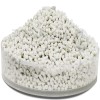Soda Lime Manufacturer Exporter BP Ph Eur USP NF AR ACS Grade Manufacturer Exporter
Crystal Clear Products is a manufacturer exporter company manufacturing several chemicals including Soda Lime and IP BP Ph Eur USP NF JP ACS AR Analytical Reagent FCC Food Grade, Pharmaceutical Chemicals at best prices. The group has offices and factories in India USA and UAE and toll manufacturers in China and sells to almost every country in the world.
The manufacturing facilities of our partner manufacturers have one or more of FDA-cGMP-GLP certification, ISO-9001 certification, Halal and/or Kosher certification, REACH pre-registration ISO-22000 HACCP. We also allow third party inspection of products offered. We can offer small quantities from laboratory and trial packs to large shipments of container loads of material.
Hazard Statements:
H315: Causes skin irritation.
H318: Causes serious eye damage.
H332: Harmful if inhaled.
H335: May cause respiratory irritation.
H402: Harmful to aquatic life.

Signal Word: Danger
Transport Information
DOT USA, TDG Canada & ADR/RID Europe:
Proper Shipping Name: SODA LIME
Hazard Class: ;8
UN/NA: UN1907
Packing Group: III.
IMDG/IMO:
Proper Shipping Name: ;SODA LIME
Hazard Class: 8
UN/NA: UN1907
Packing Group: III.
IATA/ICAO:
Proper Shipping Name: SODA LIME
Hazard Class: ;8
UN/NA: UN1907
Packing Group: III.
You may please visit:
Soda Lime SDS of Manufacturers
Soda Lime IP BP Ph Eur USP NF FCC Food AR ACS Reagent Grade Manufacturers

CAS Number 8006-28-8 Soda Lime
Soda Lime USP NF Specifications
Soda Lime is a mixture of Calcium Hydroxide and Sodium or Potassium Hydroxide or both.
It may contain an indicator that is inert toward anesthetic gases such as Ether, Cyclopropane etc. and that changes color when the Soda Lime no longer can absorb Carbon Dioxide.
Identification:
A: Place a granule of it on a piece of moistened red litmus paper: the paper turns blue immediately.
B: A solution in 6 N acetic acid responds to the tests for Calcium 191 . It also imparts a yellow color to a non-luminous flame that, when viewed through cobalt glass, may show a violet color.
Loss on drying: Weigh accurately, in a tarred weighing bottle, about 10 g, and dry at 105 for 2 hours: it loses between 12.0% and 19.0% of its weight.
Moisture absorption: Place about 10 g in a tarred, 50-mL weighing bottle, having a diameter of 50 mm and a height of 30 mm, and weigh. Then place the bottle, with cover removed, for 24 hours in a closed container in which the atmosphere is maintained at 85% relative humidity by being in equilibrium with sulfuric acid having a specific gravity of 1.16. Weigh again: the increase in weight is not more than 7.5%.
Hardness: Screen 200 g on a mechanical sieve shaker having a frequency of oscillation of 285 ± 3 cycles per minute, for 3 minutes, to remove granules both coarser and finer than the labeled particle size. Proceed as directed in the test for Hardness under Barium Hydroxide Lime, beginning with “Weigh 50 g of the granules.” The percentage of Soda Lime retained on the screen is not less than 75.0, and represents the hardness.
Carbon dioxide absorbency: Fill the lower transverse section of a U-shaped drying tube of about 15-mm internal diameter and 15-cm height with loosely packed glass wool. Place in one arm of the tube about 5 g of anhydrous calcium chloride, and accurately weigh the tube and the contents. Into the other arm of the tube place 9.5 g to 10.5 g of Barium Hydroxide Lime, and again weigh accurately. Insert stoppers in the open arms of the U-tube, and connect the side tube of the arm filled with Barium Hydroxide Lime to a calcium chloride drying tube, which in turn is connected to a suitable source of supply of carbon dioxide. Pass the carbon dioxide through the U-tube at a rate of 75 mL per minute for 20 minutes, accurately timed. Disconnect the U-tube, cool to room temperature, remove the stoppers, and weigh. The increase in weight is not less than 19.0% of the weight of Soda Lime used for the test.
Particle size: Screen 100 g for 5 minutes as directed, using a mechanical shaker. It passes completely through a No. 2 standard-mesh sieve, and not more than 2.0% passes through a No. 40 standard-mesh sieve. Not more than 7.0% is retained on the coarse-mesh sieve, and not more than 15.0% passes through the fine-mesh sieve designated on the label (as agreed between the buyer and the seller.
Soda Lime BP Ph Eur Specifications
DEFINITION
Soda Lime is a mixture of sodium hydroxide, or sodium hydroxide and potassium hydroxide, with calcium hydroxide.
CHARACTERISTICS
White or grayish white granules, or it may be coloured with an indicator to show when its absorptive capacity is exhausted. It absorbs about 20% of its weight of carbon dioxide.
Partially soluble in water; almost completely soluble in 1M acetic acid.
IDENTIFICATION
A. When moistened with hydrochloric acid and introduced on a platinum wire into a flame, imparts a yellow colour to the flame.
B. A solution in 1M acetic acid yields reaction C characteristic of calcium salts.
C. A suspension in water is strongly alkaline to litmus paper.
TESTS
Hardness of granules: Shake 200 g on a sieve no. 2000 for 3 minutes using a mechanical sieve shaker that reproduces in a uniform manner the circular and tapping motion given to sieves in manual use and has a frequency of oscillation of 282 to 288 cycles per minute. Place 50 g of the retained material in a hardness pan 20 cm in diameter having a concave brass bottom, 7.9 mm thick at the circumference, 3.2 mm thick at the centre and with an inside spherical radius of curvature of 109 cm. Add 15 steel balls, 7.9 mm in diameter, and shake on the mechanical sieve shaker for 30 minutes. Remove the steel balls, transfer the contents of the pan to a sieve no. 2000 and again shake on the mechanical sieve shaker for 3 minutes. The material retained by the sieve weighs not less than 37.5 g.
Size of granules: Shake 500 g on a perforated plate of nominal pore size 6.70 mm; not more than 5 g is retained. Then shake on a sieve no. 4750; not more than 50 g is retained. Shake the un-retained material on a sieve no. 1400; not more than 20 g passes through. Shake the un-retained material on a sieve no. 600; not more than 7.5 g passes through.
Loss on drying: When dried to constant weight at 105C, loses 14.0 to 21.0% of its weight. Use 1 g.
Moisture absorption
Place 10 g in an open glass dish about 50 mm in diameter and 30 mm high in a desiccator over sulphuric acid (14%) and allow it to remain for 24 hours. The increase in weight is not more than 7.5%.
Carbon dioxide absorption: The activity is not less than 120 minutes when determined by the following method.
Use a vertically-clamped tube of glass or other suitable transparent material about 25 cm long and 29 to 31 mm internal diameter with closely fitting rubber bungs at each end; the bungs are bored to receive polythene or glass tubing of about 8 mm external diameter, the tubing being flush with the inner ends of the bungs. With the lower bung in position, place sufficient nylon mesh support on top of the bung to produce a bed of mesh about 10 cm deep and press a closely fitting disc of stainless steel gauze of nominal mesh aperture about 500 µm on top of the nylon mesh so that its surface is at right angles to the axis of the tube. Introduce 59.8 to 60.2 g of the substance being examined onto the steel gauze in three portions, tamping lightly after the addition of each portion. Place a second disc of steel gauze on top, followed by a sufficient quantity of nylon mesh such that the soda lime is kept consolidated by slight pressure when the second bung has been inserted. The exit tube is connected to a condenser, consisting of two 50 ml separating funnels, leading to a drying tube packed with anhydrous calcium chloride and then to a carbon dioxide analyzer sufficiently sensitive to detect 0.2% v/v of carbon dioxide. A katharometer, calibrated for carbon dioxide and preferably used in conjunction with a chart recorder, is suitable.
Using the gas analyzer in accordance with the manufacturer's instructions, accurately determine the carbon dioxide content, p, as a percentage v/v, of a nominal 5% carbon dioxide mixture, the balance gas being oxygen, air or nitrogen as appropriate to the type of gas analyzer being used. Suitable compressed gas mixtures are available commercially. Assemble the apparatus described above and pass the gas mixture downwards into the absorption tube at a rate of 900 cm3 per minute until such time that the gas analyzer shows the content of carbon dioxide in the effluent gas to have risen to 0.2% v/v. Steps should be taken to vent the effluent gas if an oxygen-carbon dioxide mixture is being used. Record the time taken, t, in minutes. The activity of the soda lime is given, in minutes, by the expression tp/5.
Soda Lime Analytical Reagent Specifications
CAS Number 8006-28-8
NOTE. Soda lime is a mixture of variable proportions of sodium hydroxide with calcium oxide or hydroxide. This reagent may or may not include an indicator.
REQUIREMENTS
Carbon dioxide absorption capacity: 19.0%
MAXIMUM ALLOWABLE
Loss on drying at 200C: 7%
Fines: 1%
Contact for Monograph, Uses, Matnfacturing Process, etc of Soda Lime and JP IP BP Ph Eur USP NF FCC Food AR ACS Reagent Grade Manufacturer Supplier Exporter
MANUFACTURER EXPORTER
MUMBAI 400009, INDIA. TEL: (OFFICE) 91-9322665100
info@manufacturerexporter.com
Copyright and Usual Disclaimer is Applicable
Last updated
11/19/2022
Manufacturer Suppliers Exporters at Wholesale Prices from India USA and around the Globe
Slaked Hydrated Lime Calcium Hydroxide BP USP IP ACS AR Analytical Reagent FCC Food Grade -- Potassium Hydroxide Pellets -- Soda Lime -- Sodium Hydroxide Pellets--






